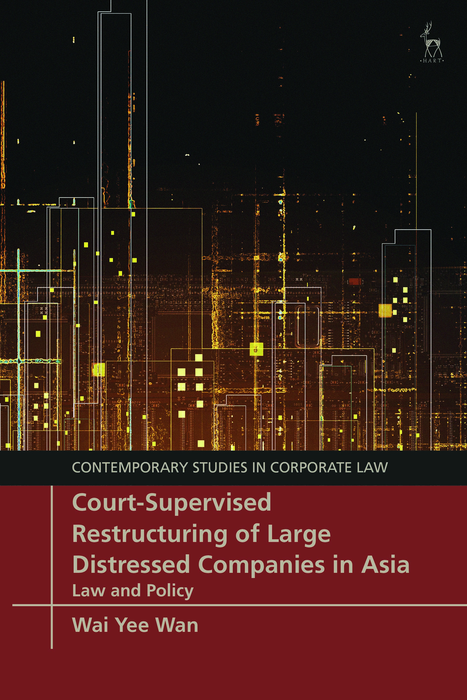A well-functioning corporate insolvency law that allows economically viable companies to restructure is critical for financial markets, especially in times like the COVID-19 period, which has resulted in widespread financial and economic distress. A new book, authored by a law professor at City University of Hong Kong (CityU), provides an in-depth analysis of four economically significant Asian jurisdictions, Mainland China, Hong Kong, India and Singapore, and offers timely policy recommendations for the design of corporate restructuring laws.

Credit: Hart Publishing
A well-functioning corporate insolvency law that allows economically viable companies to restructure is critical for financial markets, especially in times like the COVID-19 period, which has resulted in widespread financial and economic distress. A new book, authored by a law professor at City University of Hong Kong (CityU), provides an in-depth analysis of four economically significant Asian jurisdictions, Mainland China, Hong Kong, India and Singapore, and offers timely policy recommendations for the design of corporate restructuring laws.
Mainland China, Hong Kong, India and Singapore have recently reformed or are considering reforming their corporate restructuring laws. They continue to draw on, or adapt their laws from, the relevant frameworks in the United States and/or the United Kingdom. However, the institutional and market structures in Asia are very different, in particular, with a far higher concentration of controlling shareholders and different composition of creditors. The incentives of the actors, including debtors, creditors, governments, insolvency practitioners and courts, in the restructuring ecosystem are also different, and they interact in multiple and complex ways.
Local adaptation of the gold standard
Given the gap in the literature on the design of corporate restructuring laws in Asia, Professor Wan Wai-yee, Associate Dean of the School of Law, offers empirical evidence on the financial markets, major corporate defaults in the markets and corporate restructuring cases in the four Asian jurisdictions. She explains in her book, Court-Supervised Restructuring of Large Distressed Companies in Asia, published recently by Hart Publishing, that adaptation of the US/UK legal frameworks in Asia must take into account local conditions for the legal transplants to flourish in their new soil.
“Often, jurisdictions that are reforming their corporate insolvency laws draw inspiration from Chapter 11 of the US Bankruptcy Code, which is seen as the gold standard of a progressive regime. However, Chapter 11 imposes costs as well as trade-offs, which are often not recognised by proponents of Chapter 11,” argues Professor Wan.
“For instance, a debtor-in-possession regime in Chapter 11, which allows management to drive a restructuring, incentivises management to address financial problems early, but in regimes with concentrated shareholding, this process can exacerbate the conflicts between creditors and management, who are appointed by the controlling shareholders,” she explains. “Creditors want to maximise their return on the remaining assets of the debtor, but shareholders may wish to gamble on resurrection and potentially engage in wasteful and speculative acts.”
Professor Wan adds that the US bankruptcy law is based on the fact that if a company is insolvent, its remaining assets belong to the creditors, and shareholders should be excluded in the restructuring process. However, this approach disincentivises the controlling shareholders from participating in or supporting a corporate rescue that may be critical to the success of the restructuring.
In jurisdictions like the four examined by Professor Wan, characterised by companies dominated by controlling shareholders, incentivising these controllers to work with the creditors is important, even if the debtors are out of money.
An assessment framework for different policy objectives
She provides a framework for assessing how trade-offs are conducted within the differing policy objectives. The book also has a series of recommendations that advise governments on the parameters of the design of an optimal insolvency and restructuring law, which are also important for scholars, legal and insolvency practitioners, policy makers, and judges engaged in formulating corporate restructuring laws.
In her view, when a jurisdiction such as Mainland China or India is addressing high levels of non-performing loans (NPLs), the use of asset management companies as intermediaries to resolve NPLs could generate their own costs, which need to be minimised. Ownership of these intermediaries, whether state- or privately-owned, will affect the costs, so the incentives must be aligned with the true resolution of NPLs, as opposed to being mere parking vehicles for NPLs.
At the same time, insolvency practitioners have important reputational intermediary roles, but their roles can be undermined by lack of accountability, conflicts of interest, or failure to act effectively due to lack of information. Also, a regime that makes the court the final gatekeeper over the outcome of the restructuring has to provide a balance between certainty or predictability, and flexibility. This balancing act includes placing strict limits on the length of the restructuring proceedings to prevent a slow but inevitable death and allowing adaptive devices by the market participants when faced with a gap in the restructuring framework.
The work on the book was supported by a Collaborative Research Fund from the Research Grants Council in Hong Kong and funding from CityU.




